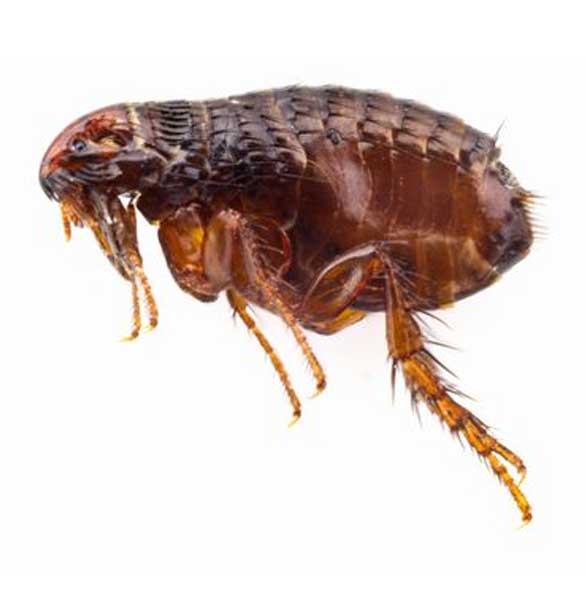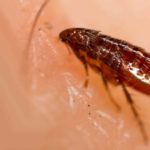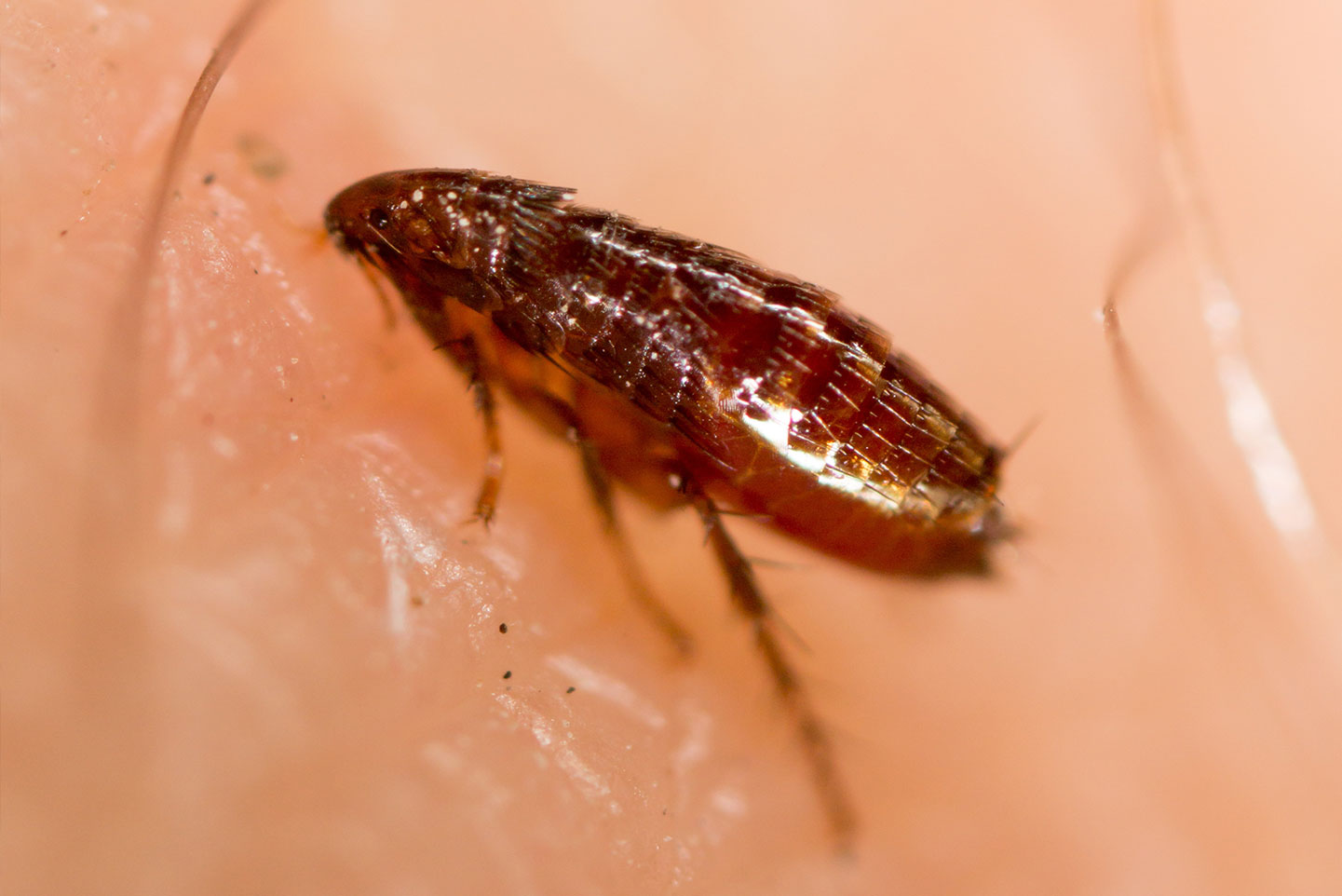(Siphonaptera)
Description
Adult fleas are reddish-brown and wingless. They are just ⅛ inch, so they are very tiny. They have hard bodies that are flattened from side to side. Their well-developed hind legs help them to jump from host to host. Adults have mouthparts that they use to pierce and suck the blood of their vertebrate hosts.

Additional Information
Habits & Behavior

A female flea will feed on 10-15 blood meals per day. Outdoors, they are generally found in shrubs and in moist, shady areas. They will hang out around your pets. Indoors, fleas can be found around your pet’s areas, such as bed, carpet, and furniture. They generally tend to stay on one pet but can move between pets that are in close proximity.
They prefer warmer weather. They will stay under a porch or deck in the winter.
Food
Fleas do not have a varied diet. Their main food is blood. Adult fleas feed on the blood of their host animals, while larvae feed on the dried blood that is expelled in the feces of adult fleas. When there is no blood around, fleas will eat other things. They will feed on dead skin and hair, as well as feathers and organic debris found within their environment.
Reproduction
A flea life cycle can vary depending on the temperature, food, and type of flea. It takes anywhere from two weeks to eight months for a flea egg to turn into an adult flea. Fleas prefer a temperature of 70 to 85 degrees Fahrenheit with humidity around 70%. These are optimal breeding conditions.
There are four stages in the flea life cycle:
- Eggs. A female flea lays 15 to 20 eggs per day on the host’s fur. These eggs are white, smooth, and oval-shaped. They are also very small, about 1/50th of an inch long. These eggs will usually fall out while your pet is sleeping or walking.
- Larvae. In 2 to 14 days, the eggs hatch into larvae that look like tiny clear maggots. The larval stage can last as long as several months. Flea larvae will eat dandruff and skin flakes. They may also feast on blood and feces given to them by adult fleas. The adult fleas poop out excess dried blood in tiny pellets known as flea dirt. Eating the flea dirt turns the larvae from a clear color to nearly purple.
- Pupae. The larva spins a white silken cocoon and molts into a pupa. This may take 7 to 10 days, but adult fleas may stay pupae for several months if it’s winter. Once the weather turns warm and humid, they’ll emerge from their cocoons as adult fleas.
- Adult fleas. Adult fleas will emerge from their cocoons as the weather gets warmer and they find animals to serve as their hosts.. A newly emerged flea can live up to a week without having a blood meal. A flea can live up to 18 months, but a more normal life cycle is 2 or 3 months.
Signs
There are more than 2,000 types of fleas in the world, but if you have fleas in your home, it’s probably the cat flea. Despite its name, cat fleas can be found on dogs and other animals.
It’s important to know the signs of fleas so you can eradicate them quickly. They are small and hard to see, so you typically need a microscope to spot a live one. However, if your dog or cat has light-colored fur, fleas may be easier to spot.
Here are some other signs that you may have a flea infestation:
- Your pet is scratching a lot. If you see your cat or dog scratching or biting at its fur, they may have fleas.
- You can see flea dirt. Fleas leave behind flea dirt, which looks like pepper. You can spot it on your pet’s skin or your pet could leave it on its bedding, the carpet, or a chair.
- You can see flea eggs around your home. Flea eggs look like tiny white ovals. While fleas will lay them on your dog or cat, they will likely fall off your pet and onto the ground. If you do not destroy them, they will hatch into larvae.
- Your pet is losing its hair. Fleas can cause your dogs and cats to itch and bite, which can cause their fur to fall out. They are commonly found at your pet’s neck and shoulder blades, but may also be at the base of the tail, along the back of the legs, and on your pet’s belly.
Dangers
While the common cat flea is not really dangerous, other species such as the northern rat flea and the ground squirrel flea can carry sylvatic plague, bubonic plague, murine typhus, and tularemia. Plagues are bacterial diseases that can cause fever, chills, weakness, and swollen lymph nodes. Murine typhus is a bacterial rash. Tularemia is also known as rabbit fever and is an infectious disease that can cause fever, skin ulcers, and enlarged lymph nodes.
Pets that are heavily infested with fleas may experience infections due to intense scratching. People and pets with allergies may develop dermatitis, hair loss, or intense itching. Cat fleas can also cause dogs to develop tapeworms. This is because adult fleas contain cysts with the tapeworms inside of them, so when cats or dogs ingest them, they can get sick.
Contact Us Today
Fleas are small but annoying creatures. They can cause allergies, itches, infections, and other diseases.
Dogs and cats can bring fleas into your home, causing these tiny pests to get into your furniture, carpets, and other living spaces. Contact Stride Pest Control right away to get fleas out of your home for good. Schedule a free consultation by calling (512) 777-1339 (Austin) or (210) 547-8410 (San Antonio) or filling out the online form.
Times their own height that a flea can jump
80
% of a flea infestation that you can see
5
Average eggs a female flea can lay per day
50
% of larvae that make up a flea population
35
Get a FREE Consultation


